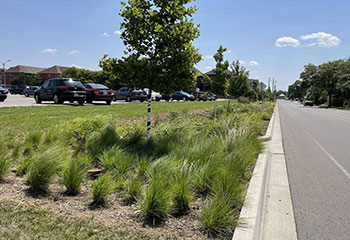
Summary
Residents and community partners of Brampton's Fletchers Creek neighbourhood crafted a Sustainable Neighbourhood Action Plan (SNAP) for climate action, including water management to slow rainfall entering the creek. They identified natural infrastructure as a cost-effective method for swift change. As a result, the City and partners established a school rain garden and roadside bioretention cells as pilot projects.
Background

Brampton is in southern Ontario and has a population of about 650,000. For its Fletchers Creek neighbourhood, the City created a Sustainable Neighbourhood Action Program (SNAP) in partnership with the Region of Peel, residents, local schools and businesses and Credit Valley Conservation (CVC), with the goal of developing a neighbourhood-scale plan for climate action and other environmental initiatives. This area covers 258 hectares of land along Fletchers Creek and is home to nearly 8,800 people.
The challenge
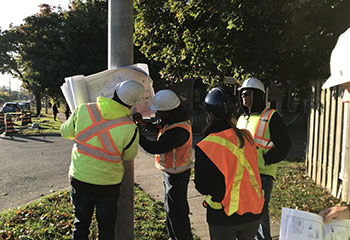
The neighbourhood features extensive pavement and minimal vegetation. During heavy rain, water rapidly flows into Fletchers Creek, leading to flooding, erosion and pollution and affecting the creek's temperature. Furthermore, the creek is habitat to the endangered redside dace fish, necessitating federal and provincial habitat protections.
Drainage concerns across the neighbourhood are prevalent. For example, post-rainfall, Glendale Public School's field often became too waterlogged for students to play on and the school wanted to revitalize an underused baseball field. The City had identified the area near Haggert Avenue as a priority in its 2015 Stormwater Management Retrofit and Enhancement Study.
The Fletchers Creek SNAP emphasized applying green-infrastructure low-impact development as a cost-effective stormwater management measure. Recognizing their swift implementation potential, the City promptly initiated two pilot projects: a rain garden at Glendale Public School and bioretention cells along Haggert Avenue.
Approach
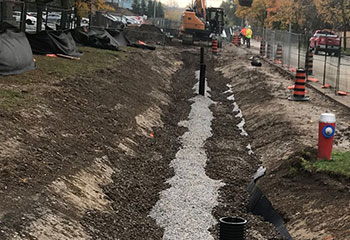
The objectives of both projects were to address drainage concerns, reduce the volume of stormwater runoff flowing into Fletchers Creek and improve water quality by slowing flow, cooling incoming water and filtering suspended solids. They also sought to curb peak stormwater surges to minimize erosion within the creek.
At Glendale Public School, with the participation of over 300 staff, students and parents, the rain garden was designed using a treatment train approach to:
- Guide runoff from the schoolyard and rooftop to the garden via a grass swale
- Capture and infiltrate 200 m3 (27mm) of runoff
- Direct rainwater into a perforated underdrain pipe so that it can enter the municipal storm sewer when the garden becomes saturated and if the control valve is open
- Enhance existing topsoil to increase its absorption capacity and infiltration rate
- Plant bird-friendly plants and add amenities like benches and pathways
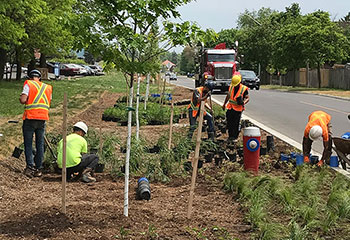
For the Haggert Avenue project, the City and CVC collaborated to design and implement three bioretention cells to capture, clean and cool stormwater runoff from the street before releasing it into Fletchers Creek. If the site experiences enough rainfall, filtered water enters a perforated underdrain that conveys it to the municipal storm sewer network. Each cell contains overflow pipes that prevent excess ponding by directly conveying overflows to the municipal storm sewer system.
Results
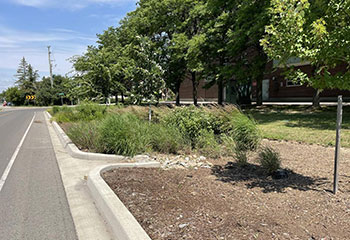
The Glendale Public School rain garden can manage runoff from a 27-mm storm event and capture up to the 90th percentile of annual rain events in the area. It has improved stormwater runoff water quality by reducing total suspended solids by 80 percent and provides heat mitigation by cooling runoff before discharging it into Fletchers Creek. It has also increased floodplain storage by a total of 800 m3, which reduces flooding potential during large storm events while also solving the school’s drainage problem.
The Haggert Avenue bioretention cells capture and treat up to 90 percent of the average annual rainfall and provide 63 m3 of stormwater storage.
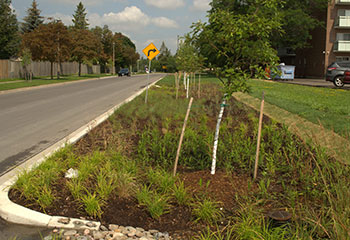
Both projects have received interest from across Canada, have been showcased on various websites such as the Sustainable Technologies Evaluation Program (STEP) and have been deemed feasible to replicate and implement at full scale. The Glendale Public School rain garden, which is estimated to be the largest rain garden in the country, has also received a Friends of the Credit Conservation Award for the collaborative work that went into the project.
Benefits
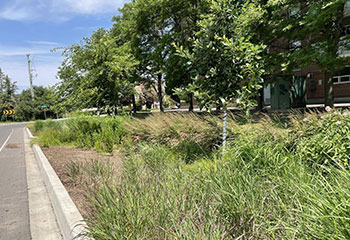
In addition to their stormwater management function, both projects are enhancing public spaces and increasing cooling tree canopy in this heat-vulnerable area of the city. They are adding significant new habitats for pollinators and supporting both terrestrial and aquatic species. The rain garden has also provided a learning opportunity for elementary school students and volunteers.
In addition, both pilots are setting an example for homeowners to implement similar projects on their own properties.
A total of 19,690 m2 of new contributing drainage area is now being serviced and a total of 85 native trees and shrubs and 5,000 wildflowers, grasses and hedges have been planted. More 600 people including residents, youth, corporate volunteers and school groups have been engaged at these projects’ locations to take hands-on action and learn about green stormwater retrofits.
Lessons learned
One major lesson learned during the implementation phase of the Glendale Public School rain garden was the importance of frequent on-site construction oversight and check-ins to prevent any issues. Choosing the right contractor is key to success. If one with previous experience constructing green low-impact development is not available, the next-best option is to find a contractor who is eager to learn.
The importance of advance planning and stakeholder engagement cannot be overlooked so that goals, objectives and priorities are defined before the design stage.
Next steps
The city continues to monitor the three bioretention cells to compare the effectiveness of the different planting plans and is identifying opportunities to install new bioretention cells and rain gardens elsewhere in the city. CVC has also moved forward on other, similar initiatives within the Credit River watershed using lessons learned from these projects, including two new school rain gardens constructed as part of the Fletchers Creek SNAP.
Want to explore all GMF-funded projects? Check out the Projects Database for a complete overview of funded projects and get inspired by municipalities of all sizes, across Canada.

